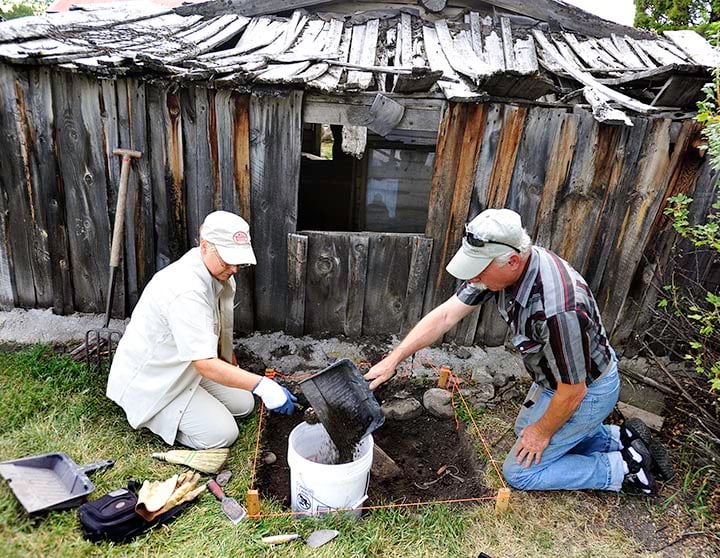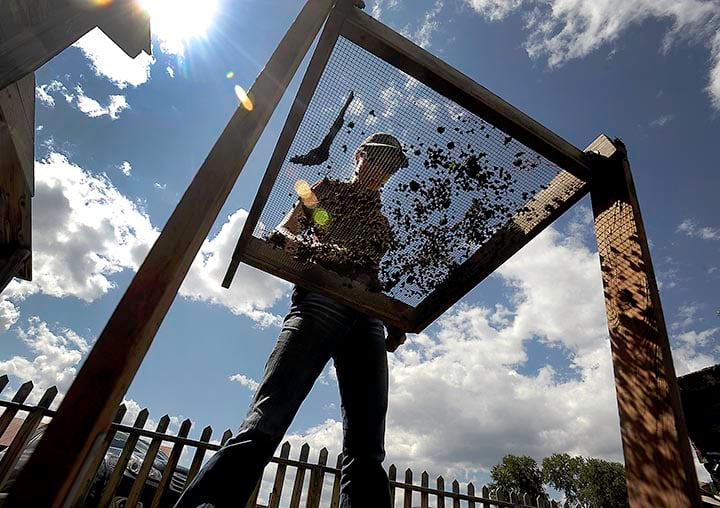NEVADA CITY— Reading, writing, arithmetic and archaeology.
“They don’t even realize they’re learning about math when they’re doing archaeology,” Crystal Alegria said, giving the measurement of artifacts as an example. “It’s a multidisciplinary science.”
Eight Montana teachers have been excavating in historic Nevada City as part of Project Archaeology, a national program based at Montana State University. The project trains teachers to design lessons for elementary students that incorporate archaeology.

Judy Stokes, a librarian at Hawthorne Elementary School and Bryan Kelly excavate a test unit at the Richards Cabin in Nevada City on Wednesday
This year, teachers from Browning to Bozeman worked on the Richards cabin, one of about 14 original Nevada City buildings.
The cabin was built in 1864 by the Richards brothers, two miners who brought their wives, children and mother to Alder Gulch in the hopes of striking it rich. The Richards were among 10,000 people who flocked to the gulch in Montana’s biggest gold rush.
Before long, the gold in Nevada City was panned out. The place was nearly empty by 1876, according to the Montana Heritage Commission.
The Richards left in 1868, but they left behind a wealth of objects to tell the story of their lives.
“Look at the size of that mouth!” Judy Stokes said, brushing off a horse’s bit uncovered in her 3-by-3-foot plot. “It’s a bit for a mule or a draft horse.”
Stokes is a librarian at Hawthorne Elementary in Bozeman. A horse owner herself, she explained that the Richards would have used mules or draft horses in their mercantile business to haul goods.

Amber Dobb, an elementary school teacher in Florence, uses a screen to sift dirt while searching for artifacts at the Richards Cabin in Nevada City on Wednesday as part of Project Archaeology, a program giving teachers hands-on learning opportunities.
“See, I’m learning, too,” said Kate McCourt, as she coached Stokes through proper measuring protocol.
McCourt is an archaeologist with the Montana Heritage Commission. She said the cabin is full of artifacts.
“We’ve found a bit, a thimble, nails, window glass, bottle glass, pieces of dishes and a saucer cup,” she said. “It’s a residential home — they usually turn up a lot of stuff.”
Before the dig is over, McCourt expects to find American Indian artifacts, too.
“I chose this old window because people just kind of threw their stuff out the window,” McCourt said.
The first step of digging is removing an 8-inch level – sediment that’s built up over the years. Underneath, excavation happens in 4-inch levels, numbered successively, until no artifacts are found for two straight levels. The artifacts are recorded and collected.
When McCourt returns to the lab in Virginia City, the artifacts will be washed, classified and entered into a database. Once organized, they will help paint a picture of the Richards’lives.
This type of deductive and critical reasoning is essential to archaeology. Alegria hopes to teach the same ideas to educators. In turn, she hopes teachers apply it in the classroom.
Teachers have been spending half the day in the field getting firsthand experience.
The advantage?
“They feel confident to go back in the classroom and teach it,”Alegria said.
A sixth-grade teacher in Browning, Bryan Kelly plans to kick off the year with an archaeology unit. He hopes to get permission for his students to help excavate around old buildings in his town. He thinks archaeology will get kids excited about learning.
Stokes said the lessons are valuable.
For example, teachers might set up a mock archaeological scenario in the classroom, encouraging students to decide how many people lived there, their ages and their hobbies.
“You take a look at the artifacts you find and you figure out what you want to know about those people, what you want to find out and what inferences you can make,” she said.
All best,
______________________
Jason Frey
Agent
PureWest, Inc.
jason.frey@purewestproperties.com
http://www.linkedin.com/in/jasonfreylifewideopen

No comments:
Post a Comment